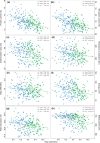Hybrid wheat: quantitative genetic parameters and heterosis for quality and rheological traits as well as baking volume
- PMID: 35112144
- PMCID: PMC9033736
- DOI: 10.1007/s00122-022-04039-6
Hybrid wheat: quantitative genetic parameters and heterosis for quality and rheological traits as well as baking volume
Abstract
Heterosis effects for dough quality and baking volume were close to zero. However, hybrids have a higher grain yield at a given level of bread making quality compared to their parental lines. Bread wheat cultivars have been selected according to numerous quality traits to fulfill the requirements of the bread making industry. These include beside protein content and quality also rheological traits and baking volume. We evaluated 35 male and 73 female lines and 119 of their single-cross hybrids at three different locations for grain yield, protein content, sedimentation value, extensograph traits and baking volume. No significant differences (p < 0.05) were found in the mean comparisons of males, females and hybrids, except for higher grain yield and lower protein content in the hybrids. Mid-parent and better-parent heterosis values were close to zero and slightly negative, respectively, for baking volume and extensograph traits. However, the majority of heterosis values resulted in the finding that hybrids had higher grain yield than lines for a given level of baking volume, sedimentation value or energy value of extensograph. Due to the high correlation with the mid-parent values (r > 0.70), an initial prediction of hybrid performance based on line per se performance for protein content, sedimentation value, most traits of the extensograph and baking volume is possible. The low variance due to specific combining ability effects for most quality traits points toward an additive gene action requires quality selection within both heterotic groups. Consequently, hybrid wheat can combine high grain yield with high bread making quality. However, the future use of wheat hybrids strongly depends on the establishment of a cost-efficient and reliable seed production system.
© 2022. The Author(s).
Conflict of interest statement
The authors declare that they have no conflict of interest.
Figures



References
Publication types
MeSH terms
Grants and funding
LinkOut - more resources
Full Text Sources

